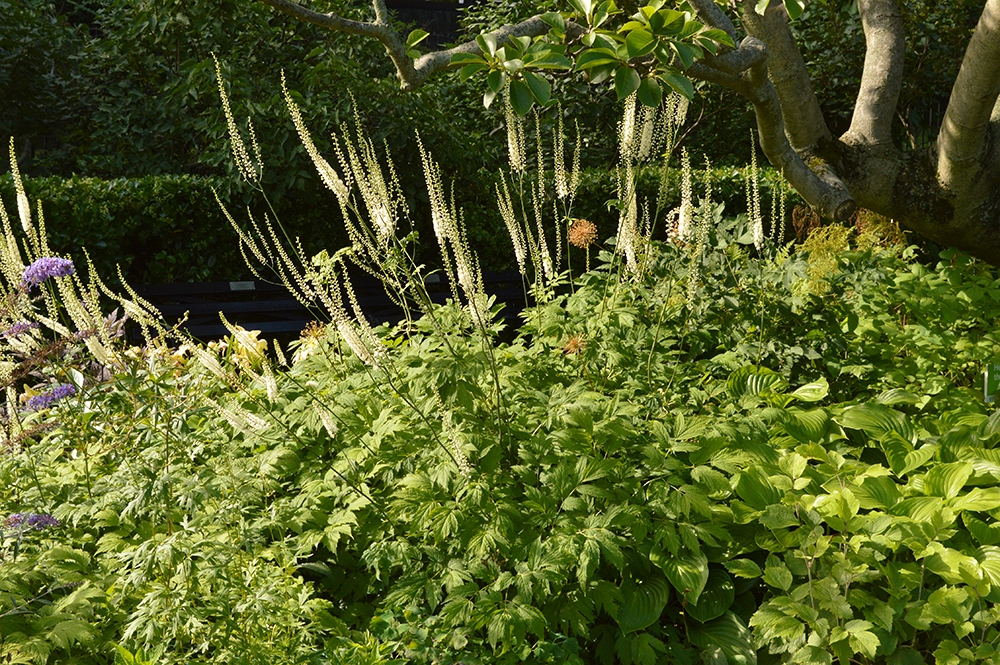I find it interesting how we often see attractive native plants in gardens long before we see them in the wild! I first saw Bugbane, botanically known as Actaea (formerly Cimicifuga) racemosa at the Connecticut home and garden of Fred and Mary Ann McGourty. Fred had been the editor for the Brooklyn Botanic Garden's informative Handbook Series and specialized in perennials, ultimately publishing a book entitled "The Perennial Gardener." Most of his knowledge came from the garden he and Mary Ann developed at their home, which they named Hillside Gardens. With a touch of genius, they had positioned a number of Bugbane plants such that you could view a small piece of statuary through the slender 6–8' tall floral stems. It created a wonderful feeling of depth and a lifelong appreciation for how best to use this elegant plant!
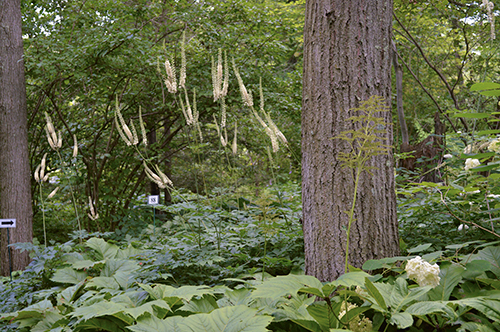
Bugbane is in the Buttercup Family or Ranunculaceae and has 12–18 species found throughout temperate regions of the Northern Hemisphere. Actaea racemosa is native from southern Ontario to Georgia and west to Missouri and Arkansas, where it is typically found in woodlands and shaded rocky slopes (as seen in Picture 1). The botanical name of the plant has certainly endured its share of change over the years and remains a point of contention with some to this day. The original genus name of Actaea was penned in 1753 by the Swedish botanist Carl Linnaeus (1707–1778). Linnaeus was most likely struck by the similarity of the foliage of Bugbane to that of the Elderberry shrub. Recognizing that the Roman naturalist Gaius Plinius Secundus, better known as Pliny the Elder (23–79 AD) had named Elderberry Aktea, he simply adopted the name for Bugbane.
However, in 1818 the British botanist and zoologist Thomas Nutall (1786–1859) changed the plants' classification to the genus Cimicifuga. Nutall studied the vegetation in North America from 1810-1841, only returning to Britain once during the war of 1812. He altered the name based on how the seed develops in dry follicles rather than in fleshy fruits, more typical of the genus Actaea. Interestingly, the name Cimicifuga was also crafted by Linnaeus in 1753, although it was not properly published until 1763 through the efforts of the Austrian botanist Johann Jacob Wernischeck (1743–1804). The name comes from the Latin Cīmex for 'bug' and Fugae for avoid or drive away, based upon the supposed ability of the plant to repel insects. The insect repelling trait also led to the common name of Bugbane. The plant remained under the name Cimicifuga until the late 1990's when genetic analysis determined it was more closely aligned with Actaea and the original genus name was reassigned. However, confusion still reigns as some authorities feel the difference in the seed-bearing structures is sufficient for the name to remain as Cimicifuga. The species epithet reflects the flower structure, with the flowers appearing along an unbranched stem called a raceme. Other common names include Black Snakeroot, which is based upon the shape of the dark brown rhizome (the spreading horizontal stem located just below the soil) and Black Cohosh. Cohosh is an Algonquin term for rough, which again describes the appearance of the dark rhizome.
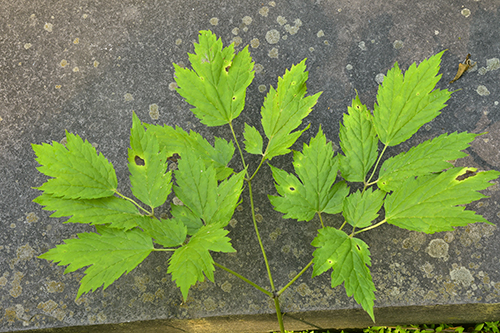
As the historical reference to Elderberry alludes, the foliage of Bugbane is very lacey in appearance. Each stem typically gives rise to three leaves located at the end the stem. Each leaf has a central stem called a rachis that in turn sprouts individual leaflets or a secondary rachis with leaflets, as seen in Picture 2. If the leaf has a central stem with leaflets arranges along the rachis it is bipinnate. If the central rachis gives rise to a secondary rachis with leaflets, it is termed tripinnate. Both such leaves are seen in Picture 2, with the central leaf being bipinnate and leaves on either side being tripinnate. As the leaves initially emerge, they are often edged in purple or have a dark purple cast to the entire leaf, which transitions to a dark green as the leaf unfurls. Each cluster of 2–3 leaves atop a stem can reach dimensions of 3' across and 2' wide. The rhizome of a plant develops numerous stems and associated leaves, which curve outward as they near their 2'+ height. This allows the leaves to become nearly parallel to the ground and best able to capture the sunlight as it hits the forest floor. Ultimately, all the foliage combined creates a very neat and tidy appearing plant with a flat top.
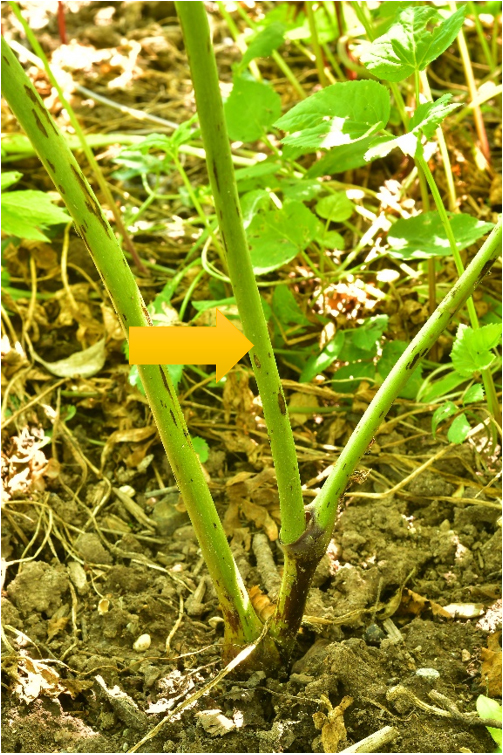
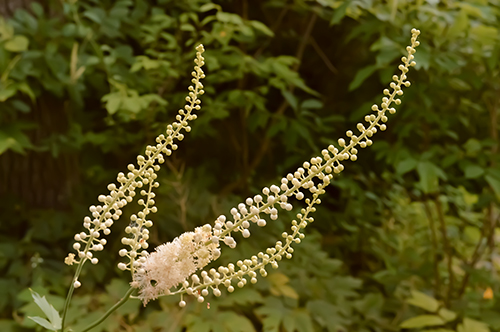
Come June into July the slender flower stems extend upwards through the foliage. The flower stems originate from a bud along the leaf stem, typically at the point where one to several leaves appear, although as seen in Picture 3, the flower stem highlighted by the arrow can branch just inches above the soil. The flower stems grow to 5–6' tall, although they can be shorter or taller, depending upon the soil fertility and moisture. They terminate in one to three racemes, with each raceme between 12–18" long and initially sporting 55–110 gleaming white buds arranged radially around the stem (as seen in Picture 4). The buds gradually open from the base upwards, with each bud yielding close to 60 white male stamens surrounding a central white stigma. Each individual flower is ⅜–½" in diameter and although there are no showy petals or leafy calyces, the flowers are still amazingly attractive! In the shaded woodland or at dusk, they appear like candles atop tall wands, inspiring yet another common name of Fairy Candles. They bear an attractive sweet fragrance with subtle acrid undertones that serves to attract a bevy of pollinators, including bees, flies, beetles and ants. Although the plant may have the reputation for repelling insects, there is certainly no shortage of pollinators who come to dine on the pollen. The plants slowly spread via the thick rhizomes as well as through seeding, allowing large colonies to develop over time.
Ideally, plants prefer filtered sunlight beneath a tall tree canopy in soils rich in organic matter that are not prone to becoming droughty. However, Bugbane can easily grow in bright light or morning sun. At Hillside Gardens, the plants were happily growing in rather moist soils where it received morning sun, although I have seen large populations blooming equally as well in dense Oak forests along rocky hillsides. The plants are not impacted by the potentially harmful chemical of Juglone from Black Walnuts and it is certainly hardy throughout NJ, naturally growing in zones 3–8.
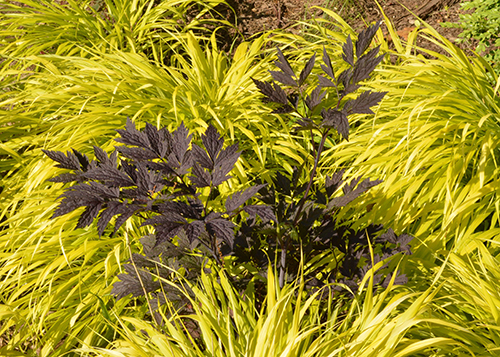
During one particular visit to Hillside Gardens, Fred was talking with great enthusiasm about a new seedling of the Asian species, Actaea simplex he had collected with the deepest, dark purple foliage he had yet to see. He named it 'Hillside Black Beauty' and indeed, it remains to this day as one of the best dark purple forms. This species was originally named in 1824 as Actaea cimicifuga var. simplex by the Swiss botanist Augustin Pyramus de Candolle (1778–1841). It was reclassified as Cimicifuga simplex in 1842, by the Danish botanist Morten Wormskjold (1783–1845), although like Linnaeus before him, he too failed to correctly publish the name.
It was not until 1888 that the German botanist Karl Anton Eugen Prantl (1849–1893) properly described the plant. Actaea simplex is a smaller plant than its North American cousin, with the foliage reaching upwards of 2' tall and the flowers a more demure 3–5' tall. The foliage is once again divided three times, and the species epithet of simplex refers to the simple, unbranched nature of the flower stem or perhaps the leaflets. The flowers appear later as well, with the white wands growing to 8" long and not opening until mid to late August.
'Hillside Black Beauty' is a member of the Atropurpurea Group, which feature various shades of purple accents to the foliage. Often, the coloring is at its best in spring and early summer, transitioning to a muddy green as summer progresses. 'Brunette' is a selection with copper-colored highlights over a green base, which yielded the seedling Fred named 'Hillside Black Beauty'. Fred's selection retains a far more steadfast coppery purple coloring throughout the summer as seen in Picture 5. It looks fantastic mixed with chartreuse, light greens and of course pink, purple and orange. The purple pigmentation is often a modified response to bright light and serves to protect the leaf from scorching. Not surprising then, 'Hillside Black Beauty' develops and retains the foliage color best in sunnier locations, providing the soil moisture is adequate. The flower racemes have a dark purple central stem and the flowers have a wash of light pink.
Despite the lure of the dark purple foliage colors, it is the majestic tall flower stems and gleaming white flowers of our native Actaea racemosa that I find most appealing. Woodland gardens have a wealth of blooms and interest in spring, yet come summer that wealth of flowers dwindle. Bugbane certainly helps to fill this void. As a bonus, the act of peering through a veil of tall leafless flower stems provides an incredible feeling of depth to a garden. This is a design trick that I 'borrowed' from an expert gardener and a trick that I hope you will 'borrow' as well!
